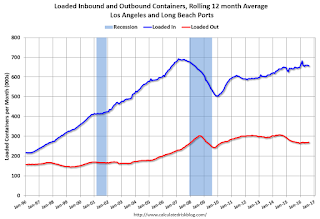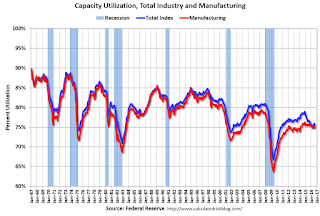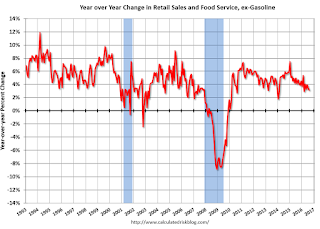by Calculated Risk on 9/15/2016 08:36:00 PM
Thursday, September 15, 2016
Friday: CPI, Flow of Funds
From Matthew Graham at Mortgage News Daily: Mortgage Rates Sidestep Near Recent Highs
Mortgage Rates were unchanged in most cases today, keeping them near their highest levels in more than 2 months. ... The most prevalent conventional 30yr fixed rate quotes are still an eighth of a point higher than they were last week, with top tier scenarios most likely to be quoted 3.5%. That said, in cases where a quote is .125% higher (e.g. 3.5% this week vs 3.375% last week), points should be slightly lower (or lender credit slightly higher, depending on the scenario). In other words, the total damage from the past few days falls just a bit shy of a full eighth of a percentage point in rates.Friday:
emphasis added
• At 8:30 AM ET, The Consumer Price Index for August from the BLS. The consensus is for 0.1% increase in CPI, and a 0.2% increase in core CPI.
• At 10:00 AM, University of Michigan's Consumer sentiment index (preliminary for September). The consensus is for a reading of 90.8, up from 89.8 in July.
• At 12:00 PM, Q2 Flow of Funds Accounts of the United States from the Federal Reserve.
LA area Port Traffic: Exports Increased in August
by Calculated Risk on 9/15/2016 05:14:00 PM
Special note: Now that the expansion to the Panama Canal has been completed, some of the traffic that used the ports of Los Angeles and Long Beach will eventually go through the canal. This could impact TEUs on the West Coast in the future.
Container traffic gives us an idea about the volume of goods being exported and imported - and usually some hints about the trade report since LA area ports handle about 40% of the nation's container port traffic.
The following graphs are for inbound and outbound traffic at the ports of Los Angeles and Long Beach in TEUs (TEUs: 20-foot equivalent units or 20-foot-long cargo container).
To remove the strong seasonal component for inbound traffic, the first graph shows the rolling 12 month average.

On a rolling 12 month basis, inbound traffic was down 0.4% compared to the rolling 12 months ending in July. Outbound traffic was up 0.9% compared to 12 months ending in July.
The downturn in exports over the last year was probably due to the slowdown in China and the stronger dollar.
The 2nd graph is the monthly data (with a strong seasonal pattern for imports).

In general exports might have started increasing, and imports are gradually increasing.
FNC: Residential Property Values increased 5.4% year-over-year in July
by Calculated Risk on 9/15/2016 02:49:00 PM
In addition to Case-Shiller, and CoreLogic, I'm also watching the FNC, Zillow and several other house price indexes.
FNC released their July 2016 index data. FNC reported that their Residential Price Index™ (RPI) indicates that U.S. residential property values increased 0.8% from June to July (Composite 100 index, not seasonally adjusted).
The 10 city MSA increased 0.8% (NSA), the 20-MSA RPI increased 0.8%, and the 30-MSA RPI also increased 0.8% in July. These indexes are not seasonally adjusted (NSA), and are for non-distressed home sales (excluding foreclosure auction sales, REO sales, and short sales).
Notes: In addition to the composite indexes, FNC presents price indexes for 30 MSAs. FNC also provides seasonally adjusted data.
The index is still down 10.0% from the peak in 2006 (not inflation adjusted).

This graph shows the year-over-year change based on the FNC index (four composites) through July 2016. The FNC indexes are hedonic price indexes using a blend of sold homes and real-time appraisals.
Most of the other indexes are also showing the year-over-year change in the mid single digit range.
Note: The July Case-Shiller index will be released on Tuesday, September 27th.
CoreLogic: "548,000 US Homeowners Regained Equity in the Second Quarter of 2016"
by Calculated Risk on 9/15/2016 11:59:00 AM
From CoreLogic: CoreLogic Reports 548,000 US Homeowners Regained Equity in the Second Quarter of 2016
CoreLogic ... today released a new analysis showing 548,000 U.S. homeowners regained equity in Q2 2016 compared with the previous quarter, increasing the percentage of homes with positive equity to 92.9 percent of all mortgaged properties, or approximately 47.2 million homes. Nationwide, home equity grew year over year by $646 billion, representing an increase of 9.9 percent in Q2 2016 compared with Q2 2015.On states:
In Q2 2016, the total number of mortgaged residential properties with negative equity stood at 3.6 million, or 7.1 percent of all homes with a mortgage. This is a decrease of 13.2 percent quarter over quarter from 4.2 million homes, or 8.2 percent, in Q1 2016 and a decrease of 19 percent year over year from 4.5 million homes, or 8.9 percent, compared with Q2 2015. ...
For homes in negative equity status, the national aggregate value of negative equity was $284 billion at the end of Q2 2016, decreasing approximately $20.4 billion, or 6.7 percent, from $305 billion in Q1 2016. On a year-over-year basis, the value of negative equity declined overall from $314 billion in Q2 2015, representing a decrease of 9.5 percent in 12 months.
Of the more than 50 million homes with a mortgage, approximately 8.6 million, or 17 percent, have less than 20 percent equity (referred to as under-equitied) and approximately 965,000, or 1.9 percent, have less than 5 percent equity (referred to as near-negative equity). Borrowers who are under-equitied may have a difficult time refinancing their existing homes or obtaining new financing to sell and buy another home due to underwriting constraints. Borrowers with near-negative equity are considered at risk of shifting into negative equity if home prices fall.
“Home-value gains have played a large part in restoring home equity,” said Dr. Frank Nothaft, chief economist for CoreLogic. “The CoreLogic Home Price Index for the U.S. recorded 5.2 percent growth in the year through June, an important reason that the number of owners with negative equity fell by 850,000 in the second quarter from a year earlier.”
emphasis added
"Nevada had the highest percentage of mortgaged properties in negative equity at 15.3 percent, followed by Florida (14 percent), Maryland (11.8 percent), Illinois (11.7 percent) and Arizona (11.6 percent). These top five states combined accounted for 33.7 percent of negative equity in the U.S., but only 18.6 percent of outstanding mortgages."Note: The share of negative equity is still very high in Nevada and Florida, but down from a year ago.
 Click on graph for larger image.
Click on graph for larger image.This graph shows the distribution of home equity in Q2 2016 compared to Q1 2016.
Less than 3% of properties have 25% or more negative equity. For reference, about four years ago, in Q3 2012, 9.6% of residential properties had 25% or more negative equity.
A year ago, in Q2 2015, there were 4.5 million properties with negative equity - now there are 3.6 million. A significant change.
Fed: Industrial Production decreased 0.4% in August
by Calculated Risk on 9/15/2016 09:23:00 AM
From the Fed: Industrial production and Capacity Utilization
Industrial production decreased 0.4 percent in August after rising 0.6 percent in July. Manufacturing output also declined 0.4 percent in August, reversing its increase in July; the level of the index in August is little changed from its level in March. Following two consecutive monthly increases, the index for utilities fell back 1.4 percent in August. Even so, the index was 1.7 percent above its year-earlier level, as hot temperatures this summer boosted the usage of air conditioning. The output of mining moved up 1.0 percent in August, its fourth consecutive monthly increase following an extended downturn; the index, however, was still about 9 percent below its year-ago level. At 104.4 percent of its 2012 average, total industrial production in August was 1.1 percent lower than its year-earlier level. Capacity utilization for the industrial sector decreased 0.4 percentage point in August to 75.5 percent, a rate that is 4.5 percentage points below its long-run (1972–2015) average.
emphasis added
 Click on graph for larger image.
Click on graph for larger image.This graph shows Capacity Utilization. This series is up 8.8 percentage points from the record low set in June 2009 (the series starts in 1967).
Capacity utilization at 75.5% is 4.5% below the average from 1972 to 2015 and below the pre-recession level of 80.8% in December 2007.
Note: y-axis doesn't start at zero to better show the change.
 The second graph shows industrial production since 1967.
The second graph shows industrial production since 1967.Industrial production decreased 0.4% in August to 104.1. This is 19.4% above the recession low, and is at the pre-recession peak.
This was below expectations of a 0.2% decrease.
Retail Sales decreased 0.3% in August
by Calculated Risk on 9/15/2016 08:43:00 AM
On a monthly basis, retail sales decreased 0.3 percent from July to August (seasonally adjusted), and sales were up 1.9% from August 2015.
From the Census Bureau report:
The U.S. Census Bureau announced today that advance estimates of U.S. retail and food services sales for August, adjusted for seasonal variation and holiday and trading-day differences, but not for price changes, were $456.3 billion, a decrease of 0.3 percent from the previous month, and 1.9 percent above August 2015. ... The June 2016 to July 2016 percent change was revised from virtually unchanged to up 0.1 percent.
 Click on graph for larger image.
Click on graph for larger image.This graph shows retail sales since 1992. This is monthly retail sales and food service, seasonally adjusted (total and ex-gasoline).
Retail sales ex-gasoline were down 0.3% in August.
The second graph shows the year-over-year change in retail sales and food service (ex-gasoline) since 1993.
 Retail and Food service sales ex-gasoline increased by 3.1% on a YoY basis.
Retail and Food service sales ex-gasoline increased by 3.1% on a YoY basis.The decrease in August was below expectations of no change for the month.
Weekly Initial Unemployment Claims increased to 260,000
by Calculated Risk on 9/15/2016 08:33:00 AM
The DOL reported:
In the week ending September 10, the advance figure for seasonally adjusted initial claims was 260,000, an increase of 1,000 from the previous week's unrevised level of 259,000. The 4-week moving average was 260,750, a decrease of 500 from the previous week's unrevised average of 261,250.The previous week was unrevised.
There were no special factors impacting this week's initial claims. This marks 80 consecutive weeks of initial claims below 300,000, the longest streak since 1970.
The following graph shows the 4-week moving average of weekly claims since 1971.
 Click on graph for larger image.
Click on graph for larger image.The dashed line on the graph is the current 4-week average. The four-week average of weekly unemployment claims decreased to 260,750.
This was lower than the consensus forecast of 265,000. The low level of claims suggests relatively few layoffs.
Wednesday, September 14, 2016
Thursday: Retail Sales, Industrial Production, Unemployment Claims and More
by Calculated Risk on 9/14/2016 06:45:00 PM
Thursday:
• At 8:30 AM ET, The initial weekly unemployment claims report will be released. The consensus is for 265 thousand initial claims, up from 259 thousand the previous week.
• Also at 8:30 AM, Retail sales for August will be released. The consensus is for no change in retail sales in August.
• Also at 8:30 AM, The New York Fed Empire State manufacturing survey for September. The consensus is for a reading of -1.0, up from -4.2.
• At 9:15 AM, The Fed will release Industrial Production and Capacity Utilization for August. The consensus is for a 0.2% decrease in Industrial Production, and for Capacity Utilization to decrease to 75.7%.
• At 10:00 AM, Manufacturing and Trade: Inventories and Sales (business inventories) report for July. The consensus is for a 0.1% increase in inventories.
Review of FOMC Projections
by Calculated Risk on 9/14/2016 02:49:00 PM
Almost all analysts are expecting no change in Fed policy at the September FOMC meeting next week.
So the focus this month will probably be on the wording of the statement, any changes to the projections, and on the press conference.
Here are the June FOMC projections. Since the release of those projections, Q2 GDP was reported at a 1.1% annual rate, after increasing 0.8% in Q1.
Currently GDP is tracking around 3.3% annualized in Q3. It seems likely the FOMC will revise down GDP for 2016.
| GDP projections of Federal Reserve Governors and Reserve Bank presidents | ||||
|---|---|---|---|---|
| Change in Real GDP1 | 2016 | 2017 | 2018 | |
| Jun 2016 | 1.9 to 2.0 | 1.9 to 2.2 | 1.8 to 2.1 | |
| Mar 2016 | 2.1 to 2.3 | 2.0 to 2.3 | 1.8 to 2.1 | |
The unemployment rate was at 4.9% in August, so the unemployment rate projection for Q4 2016 will probably be mostly unchanged.
| Unemployment projections of Federal Reserve Governors and Reserve Bank presidents | ||||
|---|---|---|---|---|
| Unemployment Rate2 | 2016 | 2017 | 2018 | |
| Jun 2016 | 4.6 to 4.8 | 4.5 to 4.7 | 4.4 to 4.8 | |
| Mar 2016 | 4.6 to 4.8 | 4.5 to 4.7 | 4.5 to 5.0 | |
As of July, PCE inflation was up only 0.8% from July 2015.
| Inflation projections of Federal Reserve Governors and Reserve Bank presidents | ||||
|---|---|---|---|---|
| PCE Inflation1 | 2016 | 2017 | 2018 | |
| Jun 2016 | 1.3 to 1.7 | 1.7 to 2.0 | 1.9 to 2.0 | |
| Mar 2016 | 1.0 to 1.6 | 1.7 to 2.0 | 1.9 to 2.0 | |
PCE core inflation was up 1.6% in July year-over-year.
| Core Inflation projections of Federal Reserve Governors and Reserve Bank presidents | ||||
|---|---|---|---|---|
| Core Inflation1 | 2016 | 2017 | 2018 | |
| Jun 2016 | 1.6 to 1.8 | 1.7 to 2.0 | 1.9 to 2.0 | |
| Mar 2016 | 1.4 to 1.7 | 1.7 to 2.0 | 1.9 to 2.0 | |
With the recent stabilization in oil prices, PCE inflation might pick up a little. But overall PCE core inflation is still below the FOMC target.
The FOMC will probably take no action at the meeting next week, and wait to see if employment gains continue - and inflation picks up.
Las Vegas: On Pace for Record Visitor Traffic and Convention Attendance in 2016
by Calculated Risk on 9/14/2016 10:07:00 AM
Another update ... during the recession, I wrote about the troubles in Las Vegas and included a chart of visitor and convention attendance: Lost Vegas.
Since then Las Vegas visitor traffic has recovered to new record highs.
As of July, visitor traffic is running 1.7% above the record set in 2015 and on pace to be 10% above the pre-recession peak.
And convention attendance has returned too. Here is the data from the Las Vegas Convention and Visitors Authority.

The blue bars are annual visitor traffic (left scale), and the red line is convention attendance (right scale).
Convention attendance is up 14.4% from the same period in 2015, after being up 14.0% in 2015 compared to 2014.
At this pace, convention attendance will set a new record in 2016, and be close to 7% above the pre-recession peak set in 2006.
There were many housing related conventions during the housing bubble, so it has taken some time for convention attendance to recover. But attendance has really picked up over the last two years.


